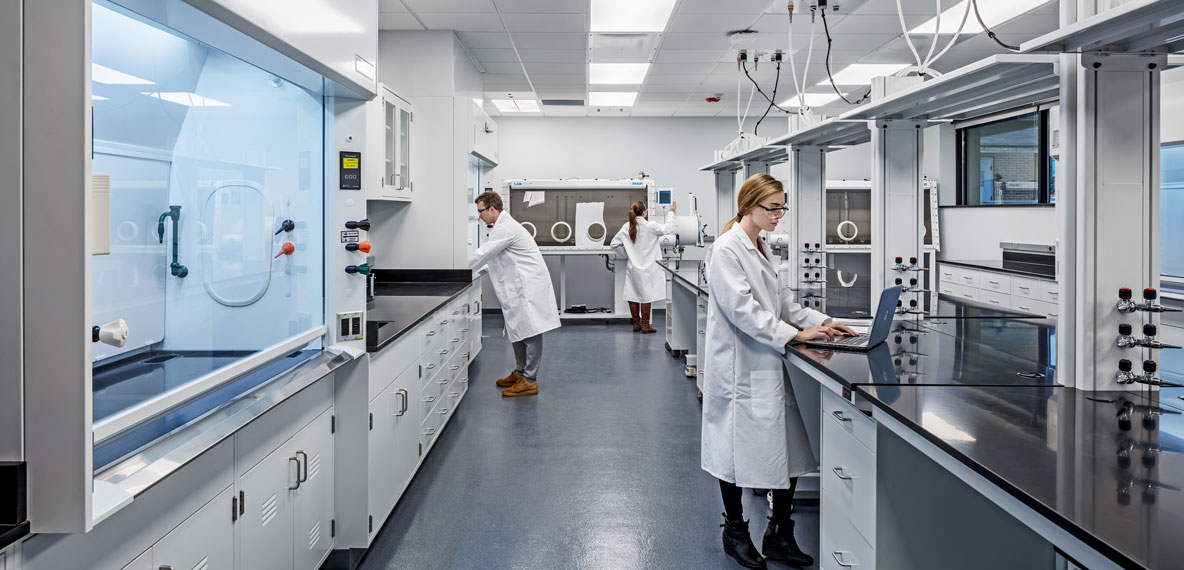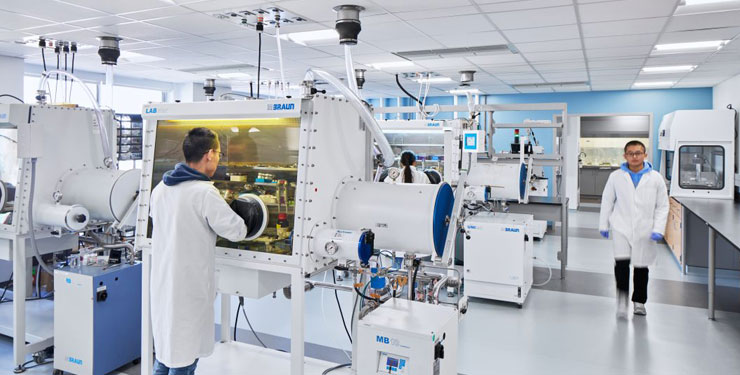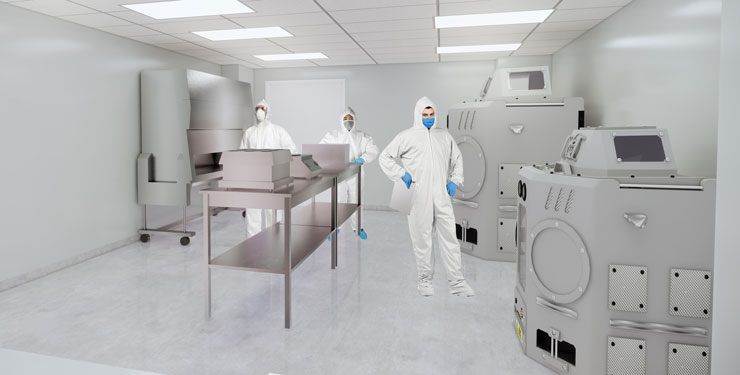
Laboratory Planning and Operations Recommendations in a Pandemic Environment

In the July 1, 2020 issue of USA TODAY, Ken Alltucker’s headline read, “Testing labs struggle as surge pushes demand,” with the subtitle, “Facilities try to expand capacity, but are limited.” There’s no question about it. The decision to reopen laboratories safely in the face of the COVID-19 pandemic plagues an industry already under stress. While these reported statistics pale compared to the 1918 flu pandemic, where an estimated 17 to 50 million people died in four successive waves from that contagion, the anxiety facing today’s workforce cannot be denied. And for laboratory workers backing up the “frontlines,” operational safety becomes increasingly critical.
Laboratory planning and operating practices for safely reopening clinical and research laboratories (they differ) entail strict adherence to designs and protocols specific to each research type’s regulatory policies. Companies’ management teams will address the physical environment (distancing, fewer workstations, PPEs, and entries, exits, layouts) accordingly. At the same time, laboratory employees will need to be trained and reminded of how to work safely, use technology intelligently, sanitize regularly, and think preventively. As a result, everyone must be flexible, stay alert to discoveries and tactics, and be aware that the science (and the virus) changes daily.
Architects Help Laboratories Reopen
Quickly, yet carefully, the immediate task is to see how best to leverage tools, processes, and technology in positive ways to get through this pandemic, learn from it, and plan for the next wave—or the next, future epidemic. Architects who design today’s science laboratories work with researchers and scientists who, by their very nature, know the importance of safe practices. Still, the new coronavirus is a pathogen whose resistance eludes the research community. The microorganism will be conquered eventually, but in the meantime, scientists need to re-confirm what is already known about protecting personnel and assets as laboratories reopen.
Immersion, diligence, vigilance, and openness to solutions that meet and exceed pandemic recommendations, including technology, UV light, humidity, and airflow considerations will be needed. The CDC and the EPA, along with local and state health departments, provide the recommendations, in conjunction with state/city government-mandated requirements by which research institutions and businesses establish their operational protocols, including pronouncements about safe-use of disinfectants. It is critical to remember that all recommendations are subject to change.
Physical Ways to Make Laboratories Safer
Nearly every aspect of a laboratory’s operational protocols and standard working procedures will require a thorough review and modification to account for social distancing practices to minimize pathogen exposure to staff. The result will be a more deliberate circulation flow of all materials and processes through the lab. Additional time will be required to sanitize work surfaces regularly and properly to prevent cross-contamination. Staff will need extra space to work, primarily to maintain the proper and most currently recommended amount of space required between individuals. Equipment will require more frequent sterilization.
On the clinical laboratory side, features can be incorporated into the new-normal from recent clinical laboratory innovations such as unidirectional workflow, the integration of a Laboratory Information Management System, molecular diagnostics testing areas, and/or a BSL-3 or BSL-4 (biosafety levels three and four) laboratory for AFB/mycology (Acid-Fast Bacilli/mycology) testing designed with proper space pressurization measures and automation of microbiology. In some laboratories, accommodations for MALDI (matrix-assisted laser desorption/ionization) and a BD Kiestra™ would be required.
Social distancing regulations will translate to additional square-foot-per-person recommendations, which will increase the building’s footprint to account for the same population. Conference rooms, breakrooms, restrooms, lobbies, corridors, and other space types where people gather will need to be larger to account for the social distancing as dictated by the virus and CDC’s recommendations. It is particularly useful to follow an iterative design approach to laboratory re-models under the frequently changing guidance directions, while still moving forward to deliver research findings and clinical laboratory results in these crucial times.
Workspaces will require enhanced protection from adjacent workers. HVAC systems should provide greater airflow and exhaust with an increased air change rate to increase relative humidity, for which the necessity is described below.
Technological and Scientific Measures to Consider
Recent findings from a June 2, 2020 study at the University of Sydney, Australia, suggested:“. . . a 1 percent decrease in humidity could increase the number of Covid-19 cases by 6 percent.” One of the study’s leaders, Professor Michael Ward, explained it. “When the humidity is lower, the air is drier, and it makes the aerosols smaller," he said. "When you sneeze and cough, those smaller infectious aerosols can stay suspended in the air for longer. That increases the exposure for other people. When the air is humid, and the aerosols are larger and heavier, they fall and hit surfaces quicker." Increased humidity in a laboratory setting should reduce the distance airborne particles contaminated with a pathogen can travel to reach and infect another person.
Another preliminary study indicates that a specific range of Ultraviolet Rays C (UVC) will sterilize surfaces without the risk of damage to human skin. The technology was developed at Columbia University's Center for Radiological Research under physicist David Brenner, who calls Far-UVC a potential "game-changer," drawing from a co-authored research report, “Far-UVC light (222nm) efficiently and safely inactivates airborne human coronaviruses.”
This promising sanitization method is being reviewed to determine its efficacy as a primary means of reducing the pathogen’s spread in a laboratory setting. Pilot testing programs are being launched at restaurants, warehouses, public transportation sites, universities, and other locations to determine if UVC can adequately decontaminate surfaces where infectious droplets may have landed. Until and even after these methods are proven to be effective, laboratory personnel and their management must continue to be alert.
Attitude Training to Ensure Wellbeing
All businesses and institutions are responsible for how guidelines and operational protocols are communicated to staff members. It will be an ongoing necessity to train staff and team members under safe distance guidelines tailored to meet and exceed pandemic recommendations. Laboratory directors must regularly review their standard operating procedures to ensure compliance with the accepted guidelines they have determined will benefit the research or testing being conducted. Posting signs throughout the lab as a reminder has the potential for increasing compliance in conjunction with continued follow-up and supervision.
With access to the tools, procedures, and equipment necessary to validate their protocols readily available within the lab, test swabs and efficacy samples can be measured through the cell culture process. In so doing, technicians can qualify their procedures for effectiveness as well as their sanitation process.
Risk of Failing to Follow Pandemic Protocols
As the well-known axiom claims, “Failing to plan is planning to fail.” The Federal, state, and local public health authorities have set guidelines and recommendations, which must be followed to ensure safe operations while changing rapidly with newer discoveries. In turn, laboratory staff at both clinical and research facilities must be trained, retrained, and monitored to ensure ongoing compliance. Protocols will be reviewed regularly to confirm consistency with the most current recommendations. Flexible staff working schedules will enhance opportunities for social distancing without increasing laboratory footprints in the shorter term.
Most importantly, the research’s quality and accuracy cannot be compromised. The focus should remain on the integrity of the research and testing being conducted during the pandemic, as it always must.
What the Future Holds
Viral outbreaks and epidemics will likely mar the future. Bill Gates would be among those to say COVID-19 is but a practice run for yet bigger epidemics at the Spanish Flu level. The science community’s clinical and research laboratories need to be prepared along with the public and private entities that run them. Architects are dedicated to making safer laboratories as society reopens from the current pandemic and preparing for the future because scientists and researchers cannot work from home—yet. It could be science fiction, but some indications profile a reality wherein architects and engineers will design scientific laboratories for machines, not people. In our recognizable future, buildings emptied by the coronavirus—from universities to retail chains to downtown skyscrapers—could house robots. Computer-assisted androids might run experiments, titrate for the next vaccine, commandeer clinical trials, crunch data, and conduct contact tracing all at an arms-length, safe distance from humans controlling them from their home offices, or another safe-distance work zone.
For now, safer research laboratories will be an essential stepping-stone to finding the cure, defeating the novel coronavirus, and moving onto a secure, new-normal future.
This article was originally published in Labcompare.
Content Type
Published Articles
Date
September 15, 2020
Market
Practice
Laboratory Planning
Topic
Laboratory Design
Hybrid Work


